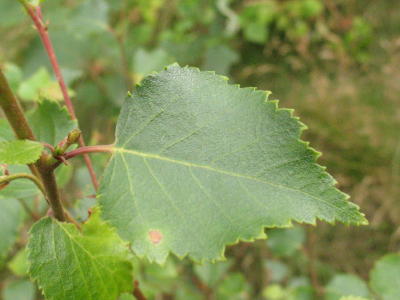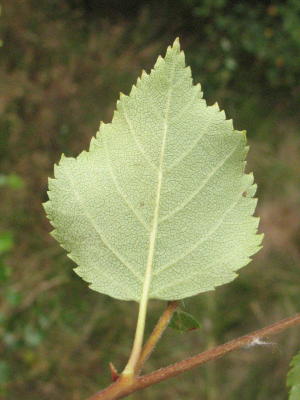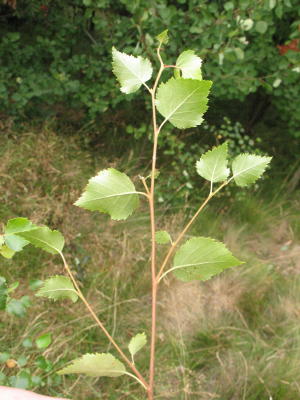Birch is one of the most common of Britain’s native broad-leaved trees. The grows well all over Britain although Downy Birch is more common in Scotland. It grows as quite a tall tree although sometimes will grow small like a shrub but always with elegant, drooping branches, a light canopy and whip like twigs.
3 species of Birch grow wild in the British Isles.Birches
are grown for their beautiful bark which, on some species, constantly peels
to reveal the new and lighter bark underneath.The leaves turn yellow in
autumn.
Silver birch Betula pendula
Downy Birch
Dwarf Birch Betula nana
The dwarf Birch Betula nana, seldom bigger than
a shrub, is found locally in the Scottish Highlands - it is one of the
world's hardier plants, able to flourish even on the tundra.
The two that grow to tree size in Britain are the Silver or Warty Birch,
Betula pendula - and the Downy Birch, Betula pubescens.
Distinguishing
Silver birch (Betula pendula)
Silver Birch twigs are hairless but bear tiny warts and vice versa for
Downy.
The leaf edges in the Downy Birch only have a single series of teeth - they are double-toothed in Silver Birch.Both have white bark as the tree gets older - but it is particularly bright in the Silver Birch
Normally the Downy Birch is a smaller tree, with more upright branches and becomes commoner as you go North and West in Britain where it often grows on damp, peaty moorlands.
Silver Birch branches droop at the tips - which is why its scientific name is pendula or hanging. To complicate matters, some individual trees show characters intermediate between these two species; these are normally hybrids.
Location
Birches are found naturally in Northern Europe.
They are pioneer species, with light wind blown seeds, that can grow quickly
on bare land without being planted. Birch prefer light, dry and acid soils
but are also able to cling to rocks and mountain sides. They can grow in
cold climates and further North than any other tree; distinctive and shrub
like Downy Birch in the Scottish highlands and the Dwarf Birch in the arctic
circle. These invasive characteristics and its’ tolerance to pollution
make it ideal for establishing trees on exposed and industrial sites.
Wildlife
The Birch has high conservation value. The light, open canopy with spaced, small leaves give light shade on the woodland floor. This allows varied ground flora especially mosses, grasses and flowering plants to grow.This means plenty of food for a wide range of insects, birds and many other animals. The Chaffinch, Tree Pipit, Willow Warbler, and Robin are characteristic to Birch woodlands. You may also find the Woodcock, Nightingale, Woodpecker or Redpoll.
Birch is tolerant and can withstand the wind,
hard frosts and strong sunshine. Birchwoods in Scotland, for example, are
particularly valuable as shelter from the weather for sheep and other animals.
Birch biology
 Birch catkins open about
April along with the leaves.Birch is wind pollinated - the male catkins
or lamb's-tails shed the pollen and later break up.The pollen blows onto
the female catkins which are smaller and stand erect looking like bristly
green caterpillars - during the Summer the fertilised female catkins ripen,
grow longer and eventually hang down to release the winged seedlings which
are carried away on the mid-Autumn wind.Seeds that alight on suitable substrates
germinate and sprout the next Spring; Birches are typical "pioneer"
trees, able to invade and colonise bare land successfully. A mature Birch
can reach 60 years.
Birch catkins open about
April along with the leaves.Birch is wind pollinated - the male catkins
or lamb's-tails shed the pollen and later break up.The pollen blows onto
the female catkins which are smaller and stand erect looking like bristly
green caterpillars - during the Summer the fertilised female catkins ripen,
grow longer and eventually hang down to release the winged seedlings which
are carried away on the mid-Autumn wind.Seeds that alight on suitable substrates
germinate and sprout the next Spring; Birches are typical "pioneer"
trees, able to invade and colonise bare land successfully. A mature Birch
can reach 60 years.
Uses of Birch
Both timbers of these Birches is similar but of
little commercial value in Britain at present although in Scandinavia,
where the trees are larger and straighter, the wood is used for furniture
and when peeling the veneers, for use in Birch plywood.In Britain, the
smaller trees are used for turnery to produce broomheads, tool handles
and many kinds of small wooden objects.Birch logs burn well, the twigs
are still used for sweeping brooms or besoms, and for steeplechase jumps.Silver
Birch are popular garden trees and other Betula species, particularly those
with whiter trunks are widely available.A powerful diuretic, yet kind on
the kidneys, can be concocted from Birch leaves and wine fermented from
the rising sap in Spring


